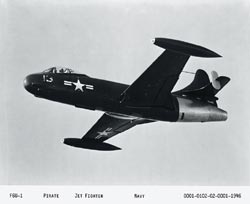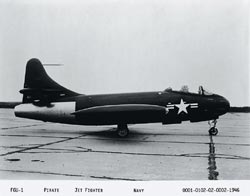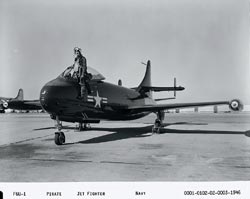|
 The F6U-1 was equipped with an afterburner and wing tip tanks. The vertical-tail and horizontal-tail leading edges had dorsal-type extensions. The horizontal stabilizer had fins. The dorsal extensions and the fins were added to make directional stability acceptable The F6U-1 was equipped with an afterburner and wing tip tanks. The vertical-tail and horizontal-tail leading edges had dorsal-type extensions. The horizontal stabilizer had fins. The dorsal extensions and the fins were added to make directional stability acceptable
Unique Features
- First production afterburner installation in the U.S.
- Four 20-mm M-3 (T-31) cannons with 150 rounds of ammunition in each of four boxes
- Constant-Mach-number, hydraulically-actuated speed brakes which limited the maximum Mach number of the airplane in a dive.
- Kneeling nose gear in lieu of wing fold for carrier deck spotting.
- Elevator spring and balance tabs to lighten longitudinal stick force.
- Pilot ejection seat.
- AN/ APX-1 IFF (Identification friend or foe system)
- Metalite panels used to cover wing, fuselage, and tail surfaces.
- Dorsal-type extensions on vertical-tail and horizontal-tail leading edges.
- Fins attached to horizontal stabilizer.
Engine
 The basic engine for the F6U-1 was the Westinghouse J34-WE-30A rated at a 3200-pound static thrust less 12% for installation loss. The afterburner (Solar Model A-103B) produced approximately 30% boost by adding fuel to burn residual oxygen. The powerplant consisted of an 11-stage axial flow compressor, a double annular engine combustion chamber, and a two-stage turbine, plus the afterburner combustion chamber, two-position nozzle, cooling shroud and controls. Engine-driven accessories consisted of an all-speed governor, main and emergency (automatic) fuel pumps, lubricating system pump, hydraulic pump and generator. The engine compartment was cooled by air taken in by boundary layer ducts at the wing roots and exhausted at a gill forward of a firewall on the bottom centerline. The afterburner compartment was cooled by air entering through two flush scoops on the lower fuselage aft of the firewall and out by nozzle shroud ejector action. The basic engine for the F6U-1 was the Westinghouse J34-WE-30A rated at a 3200-pound static thrust less 12% for installation loss. The afterburner (Solar Model A-103B) produced approximately 30% boost by adding fuel to burn residual oxygen. The powerplant consisted of an 11-stage axial flow compressor, a double annular engine combustion chamber, and a two-stage turbine, plus the afterburner combustion chamber, two-position nozzle, cooling shroud and controls. Engine-driven accessories consisted of an all-speed governor, main and emergency (automatic) fuel pumps, lubricating system pump, hydraulic pump and generator. The engine compartment was cooled by air taken in by boundary layer ducts at the wing roots and exhausted at a gill forward of a firewall on the bottom centerline. The afterburner compartment was cooled by air entering through two flush scoops on the lower fuselage aft of the firewall and out by nozzle shroud ejector action.
Speed Brakes
The hydraulically-actuated speed brakes limited the maximum Mach number of the airplane in a dive so that during normal fighter operations, the transonic region of high buffet and/or trim change would not be reached. Mild buffet was encountered at a Mach number of 0.79 in level flight. At approximately 0.80 Mach number, a nose down trim change (also known as tuck-under) occurred on some F6U-1's. This tuck-under could be delayed to a higher Mach number or made into a tuck-up condition by making a very small change to the stabilizer incidence by the addition of one or two washers at the forward or aft attach points. This compressibility problem was common to high subsonic aircraft of the 1940's which used a fixed stabilizer for longitudinal stability and an elevator for longitudinal control. In the 1950's, the fix was to go to all-moving (unit) horizontal tails with irreversible power controls.
Metalite Panels
Metalite panels covered the wing, fuselage, and tail surfaces. The panel material was a low-density balsa wood core bonded on both sides to aluminum skin. The panels were formed in molds, cured in a large autoclave and joined to the support structure with rivets. The inherent stiffness in the material maximized surface smoothness thus reducing drag.
Production
 The first three F6U-1 Pirates were manufactured in Stratford, Connecticut and then partially disassembled and shipped by truck to the new plant in Dallas, Texas. After the 1700-mile trip, each airplane was reassembled. Production was begun in Texas on the remaining 27. The first three F6U-1 Pirates were manufactured in Stratford, Connecticut and then partially disassembled and shipped by truck to the new plant in Dallas, Texas. After the 1700-mile trip, each airplane was reassembled. Production was begun in Texas on the remaining 27.
When the first F6U was ready to fly, the runway at adjacent Hensley Field at Dallas had not yet been lengthened to permit flight testing of the Vought airplanes. Arrangements had to be made for another test site. The Pirate program resumed at Ardmore Oklahoma until Hensley Field was finished. By that time, the 1944 F6U design was outdated and all F6U airplanes, save one, were relegated to various Navy sponsored research units. One of the thirty F6U-1’s was later modified by Langley Field to carry cameras and designated F6U-1P.
F6U-1:
Production Flight Test Incident
Afterburning
|